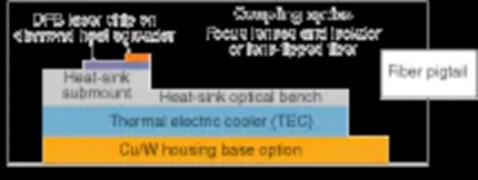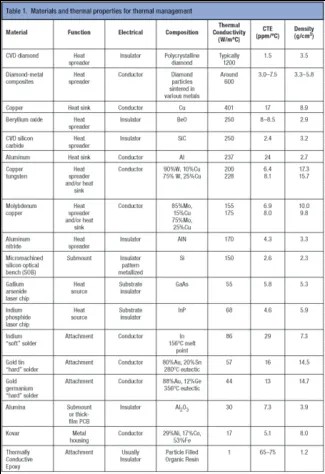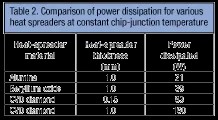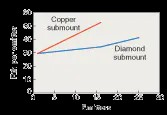The heat-spreader assembly can be a major bottleneck for thermal management of junction temperature of optoelectronic and electronic devices. With high thermal conductivity, diamond heat sink can improve the cooling capability of a chip.
The ability to increase the optical output power of laser diodes and light-emitting diodes (LEDs) without reducing device reliability or lifetime is highly constrained by device packaging methods and materials choices. Thermal management of the laser and LED junction temperature is dominated by the heat spreader attached to the chip as part of the total assembly.
Heat-spreader function
Heat spreaders rapidly remove heat generated by optoelectronic device emitters through thermal conduction to a heat sink. The heat spreader also spreads the heat from the smaller area of the chip to the larger heat sink. Optoelectronic device performance, such as emitted-light wavelength and conversion efficiency, is dependent upon the junction temperature on the chip-lower junction temperature means better device performance and longer lifetime.
In a distributed-feedback (DFB) edge-emitting laser, the laser chip sits on its heat spreader, which then rests on top of a heat-sink submount and optical bench (see Fig. 1). Underneath the optical bench, a thermoelectric cooler (TEC) can be placed for active temperature control. The heat-sink optical bench or TEC is attached to the device package base through which laser chip and TEC heat is discharged to the printed-circuit-board (PCB) mount. Common device configurations include butterfly, dual-inline (DIL) and mini-DIL Kovar packages, TO-can packages, as well as other small-form-factor (SFF) configurations.

FIGURE 1. Diamond heat spreaders are easily integrated within laser-diode and LED packages.
Assembly of these lasers involves multiple subcomponent attachment process steps, typically using a variety of hard and soft solders. Attachment of the laser chip to the heat spreader is at the top of this solder hierarchy with gold tin (AuSn) or gold germanium (AuGe) hard solders. Devices with fewer assembly attachment steps may use lower-temperature solders such as indium. Common heat spreaders include diamond, aluminum nitride (AlN), and beryllium oxide (BeO). High-power laser chips and LEDs typically use copper heat sinks

Thermal management
The heat-spreader assembly is a major bottleneck for management of junction temperature. Therefore, successful device manufacturers must pay special attention to materials choice and heat-spreader assembly design.
When compared to conventional materials, chemical-vapor-deposition (CVD) diamond is emerging as an effective heat spreader by a large margin. Diamond has a much greater thermal conductivity than other material choices-three times greater than copper, five times greater than AlN or BeO, and five times greater than refractory metals such as copper tungsten or molybdenum copper (see Table 1). Diamond-metal composites made from diamond particles sintered in various metal choices can provide tailoring of heat-spreader coefficient of thermal expansion (CTE) with thermal conductivities better than copper but half that of CVD diamond.

The Kinik Company of Taiwan demonstrated the superior cooling capability of diamond heat spreaders relative to conventional ceramic heat spreaders in 2003. Computer chips were mounted on heat spreaders and operated at power levels that produced a constant 110°C chip junction temperature (see Table 2). Diamond heat sink of the same thickness were able to remove 7.6 times more heat than alumina heat spreaders and 4.1 times more heat than BeO heat spreaders.
In another example of improved optoelectronic device power enabled by using diamond, the thermal resistivity (Rth) of multiple-emitter vertical-cavity surface-emitting arrays was measured on copper and diamond substrates and the Rth with the diamond substrate was 34.5% less than with the copper (see Fig. 2).

FIGURE 2. A reduction in the thermal resistivity, Rth, of vertical-cavity-surface-emitting (VCSEL) arrays is observed when using diamond heat spreaders for thermal management compared to copper. The resistivity reduction translates to improved power levels for the VCSEL arrays.
 闽ICP备2021005558号-1
闽ICP备2021005558号-1Leave A Message